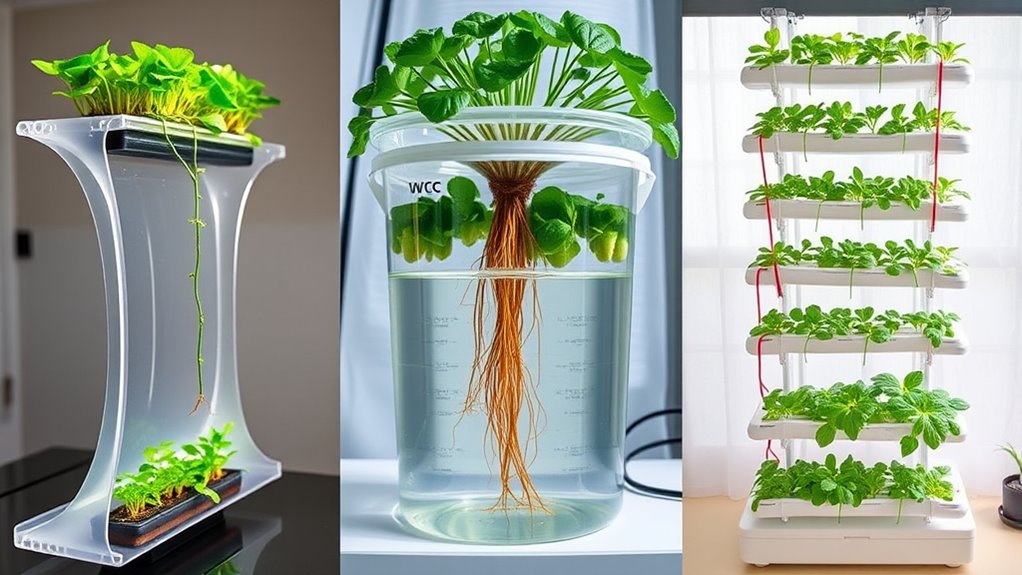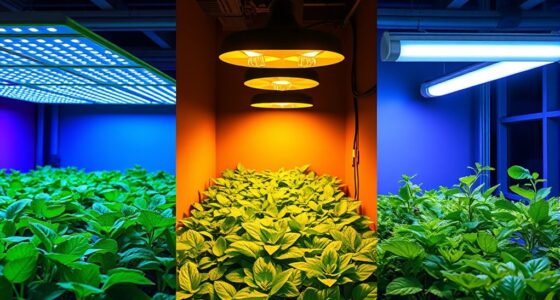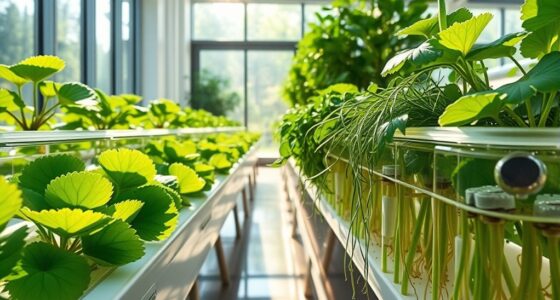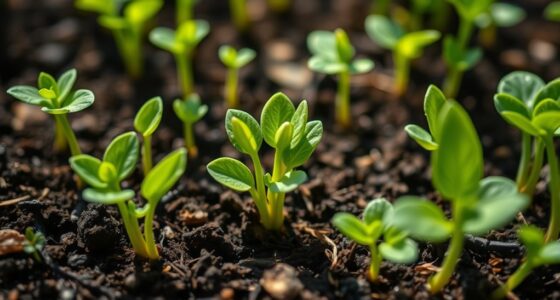When choosing a DIY hydroponic system, consider the strengths of each setup: NFT uses a thin flow of nutrients ideal for quick harvests but needs consistent monitoring; DWC suspends roots in oxygenated water, promoting fast growth but requiring regular checks and maintenance; drip irrigation delivers nutrients directly to roots, offering customization but needing careful management of flow and clog prevention. Understanding these options helps you pick the right system for your space and goals; more details await you.
Key Takeaways
- NFT uses a thin nutrient film flow, ideal for quick harvests but sensitive to clogs and pump failures.
- DWC suspends roots in oxygenated water, promoting rapid growth but requires regular monitoring of water quality.
- Drip systems deliver nutrients directly to roots, offering high customization but need frequent emitter maintenance.
- All systems require consistent nutrient solution management, component cleaning, and flow monitoring for optimal growth.
- Consider system complexity, space, and maintenance capacity when choosing between NFT, DWC, and drip irrigation setups.

Are you interested in growing fresh vegetables at home without soil? If so, exploring different DIY hydroponic systems can be exciting and rewarding. Among the most popular setups are Nutrient Film Technique (NFT), Deep Water Culture (DWC), and drip irrigation systems. Each offers unique advantages and challenges, so understanding their differences helps you choose the right one for your space and experience level.
Starting with NFT, this system involves a thin film of nutrient solution flowing over the roots of plants in a slight incline. It’s efficient and uses less water and nutrients compared to other methods. However, for successful operation, you need to maintain a consistent flow of nutrient solutions to prevent roots from drying out or becoming waterlogged. Regular system maintenance is vital because clogs in the channels or pump failures can quickly jeopardize your plants. NFT is ideal if you want a system that’s relatively simple to set up and quick to harvest, but it requires close monitoring to ensure the nutrient film stays at the right depth and flow rate.
In contrast, DWC involves suspending plant roots directly in a nutrient-rich, oxygenated water reservoir. This setup is straightforward to assemble and provides plants with constant access to nutrients and oxygen, promoting rapid growth. To keep this system running smoothly, you must pay attention to nutrient solutions’ composition and pH levels, adjusting them as needed. System maintenance here involves regular checks of the water level, oxygenation (using air stones or diffusers), and cleaning the reservoir to prevent algae or pathogen buildup. DWC is forgiving if you’re new to hydroponics but still demands routine oversight to maintain ideal conditions.
Drip irrigation systems deliver nutrient solutions directly to each plant’s root zone through a network of tubes and emitters. This method offers high flexibility, allowing you to customize watering schedules for different plants. It’s particularly well-suited for larger setups or integrating into existing garden spaces. Proper system maintenance involves inspecting emitters for clogs, ensuring consistent drippers flow correctly, and managing nutrient solutions carefully. Since these systems can be more complex, your focus must be on preventing blockages and maintaining the correct nutrient concentration to avoid deficiencies or excesses. Drip systems, when maintained properly, provide a reliable and scalable way to grow a variety of crops.
No matter which hydroponic system you choose, understanding nutrient solutions and system maintenance is key to success. Regularly checking your setup, keeping nutrient levels balanced, and cleaning components prevent problems and help you enjoy a continuous harvest of fresh vegetables. Additionally, being aware of cybersecurity vulnerabilities, such as potential threats to automated systems, can help protect your home garden setup from digital risks. Each setup has its own learning curve, but with patience and attention to detail, you can create a thriving indoor garden that produces healthy, delicious produce year-round.
Frequently Asked Questions
Which Hydroponic System Is Best for Small Indoor Spaces?
For small indoor spaces, you want space-saving setups with compact design options. NFT systems are ideal because they use thin channels and require minimal space, making them easy to fit into tight areas. DWC setups can also work if you choose smaller containers, but they tend to be bulkier. Drip irrigation might take up more room due to tubing and reservoirs. Prioritize NFT for a sleek, efficient solution that maximizes limited space.
How Much Does a DIY Hydroponic Setup Typically Cost?
Imagine your indoor garden flourishing with lush greens; now, think about the cost estimate to make that happen. A DIY hydroponic setup generally costs between $50 and $300, depending on your equipment budget. You’ll need supplies like reservoirs, pumps, and grow trays, but you can start small and upgrade gradually. With some basic tools and creativity, you’ll create a thriving garden without breaking the bank.
What Are Common Beginner Mistakes in Hydroponic Gardening?
When starting hydroponic gardening, you might overlook common beginner mistakes like neglecting nutrient imbalance and water pH levels. You should regularly check and adjust water pH to prevent nutrient lockout. Also, avoid overfeeding or underfeeding plants, which causes nutrient imbalance. Failing to monitor these factors can stunt growth or harm your plants. Stay vigilant, test frequently, and keep records to make certain your plants thrive.
How Do I Troubleshoot Nutrient Deficiencies in My System?
Imagine your plants whisper for help, signaling nutrient gaps. You should check for pH imbalance, as it can lock out essential nutrients, and inspect roots for signs of rot. Adjust pH levels if needed, and guarantee proper oxygenation to prevent root rot. Regular monitoring and timely intervention keep your system thriving. By catching issues early, you help your plants flourish, avoiding more serious setbacks.
Can These Systems Be Used for Growing Herbs and Vegetables Together?
Yes, you can grow herbs and vegetables together in these systems, but consider companion planting to optimize growth and prevent pests. Mix compatible plants that benefit each other, and rotate crops regularly to reduce nutrient depletion. Adjust your nutrient mix to meet diverse plant needs, and monitor for signs of deficiencies. This approach helps maximize space, promotes healthier plants, and creates a balanced, productive hydroponic garden.
Conclusion
So, now you’re a hydroponic expert, ready to grow your own lush garden without soil. Just remember, whether you’re mastering NFT, DWC, or drip systems, it’s all about patience and a bit of trial and error. Ironically, your high-tech setup might just turn into a jungle of tangled roots or a waterlogged mess, proving that even with the best plans, nature loves to keep us on our toes. Happy growing—may your plants thrive, and your mistakes be few!










